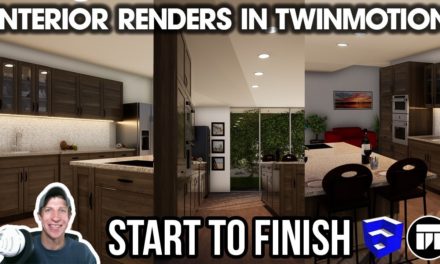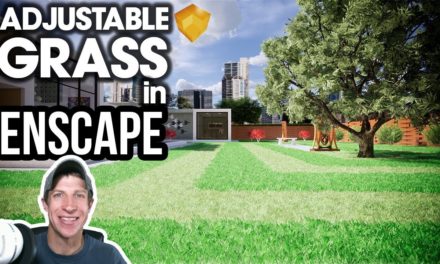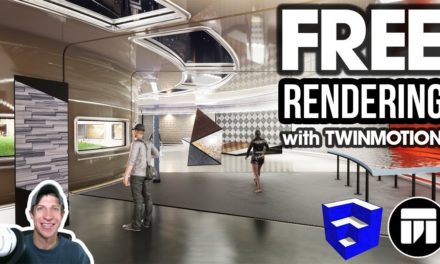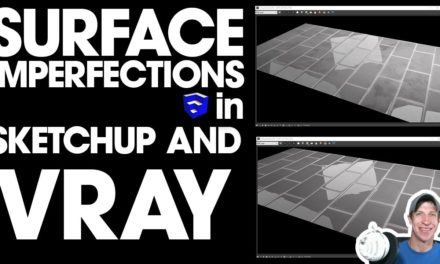GETTING STARTED WITH VRAY MATERIALS – Vray Rendering for SketchUp Tutorial
In this video, learn the basics of applying qualities to materials in Vray for SketchUp to create photorealistic materials!
Do you like these SketchUp tutorials and videos?
If so, please consider supporting me on Patreon (click here to support) or by visiting my Support the Show Page!
THE SKETCHUP ESSENTIALS COURSE
http://www.thesketchupessentials.com/course
DOWNLOAD VRAY
https://www.chaosgroup.com/
So far, when working with Vray, we’ve talked about lighting our models – now I want to give you an introduction to working with materials in Vray.
- To start off, material editing in Vray 3.6 occurs within the asset editor, which can be found in the Vray for SketchUp toolbar. Click on the circle with the checkerboard pattern to access the material editor.
- When you first open up the material editor, you’re going to see a list of the materials currently contained in the SketchUp model. Notice that this will correspond with the materials contained in the “In Model” dropdown of your material editor in SketchUp. If you click on any of these materials, your material preview will show you a preview of what that material is going to look like within your Vray Rendering. In addition, you can also preview your material in different uses by clicking on the 3 dots next to your material preview.
- If you right click on the material, there are several different options that you’re going to find useful, including the ability to select all objects with a certain material applied to them, the ability to apply materials to selected objects in your SketchUp scene, and more!
- The way that rendering materials in Vray works is that you apply a texture to an object in SketchUp, then you apply different presets and settings to those materials to tell Vray how to treat those materials when it renders them. There’s two ways to do this – you can either adjust the settings of a SketchUp material, or you can apply a Vray material to your model. Let’s talk about adjusting our material settings first, then we can talk about using Vray’s built in materials to create our renderings.
- Next to your material list, there’s an option for quick settings – this is a quick area where you can apply different settings to your materials. You can also click the right arrow button to access more in-depth settings for your materials. There are a LOT of settings that you can adjust within Vray, and I’m not going to be able to get to all of them in this video. If there’s enough interest, I may create a video or even a series of videos talking about each one of these presets, so leave a comment below and let me know!
- In this case, let’s apply some colors to these spheres within SketchUp, then play around with their settings to see what kind of results we can achieve. Notice that when I select a material with the SketchUp eyedropper, the material also gets selected within Vray. To start off, let’s apply a preset of “Paint” to the first sphere within the quick settings of Vray. Notice that when we do this, our material preview changes to show the change to the settings we just made. In this case, a paint material is somewhat reflective, and has a glossiness to it. Notice that if we drag the slider for the reflection glossiness, the material gives a more clear reflection. Run a quick render and you can note that this material reflects both the sunlight around it, as well as the other spheres next to it.
- For the second material, apply a “Metal” preset to it. Note that this material has a higher glossiness, and also a high IOR, or Index of Refraction, which describes the way that light bends along the surface. It also has a very low diffuse color value (the actual color of the object), but a very high reflection value (which is the color of the light being reflected).
- For the third material, apply a glass preset. Note that this preset has a series of different options than the other materials because it actually allows light to pass through it. This preset has a series of sliders that allow you to adjust refraction (how an object allows light to pass through), as well as the fog color (which adjusts the color the light takes on as it passes through). You can also affect the glossiness of the reflection, and changing the IOR affects the way that light bends as it passes through the object.
- Finally, let’s apply a material of plastic to the last object. Note that this shares a lot of the characteristics of the paint material, so the effect generated is very similar.
- There are a lot of things that adjust the realism of materials, including lighting, textures, other things as well. In the next video, I want to talk a bit more about using materials with actual texture images applied to create realistic looking textures.
Leave a comment below and let me know what you thought!
About Justin Geis
Hi, I'm Justin Geis, and I'm the founder of The SketchUp Essentials. I started using SketchUp as part of my work as a general contractor in 2008. I quickly realized the power of the software and started using it for personal projects. I started The SketchUp Essentials as a place to share easy to follow SketchUp tutorials and tips to help everyone harness the power of 3D Modeling in their lives. When not working with SketchUp, I enjoy playing soccer and spending time with my wife and our two dogs.




